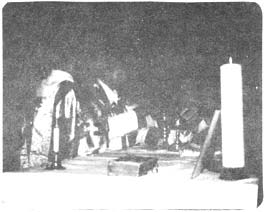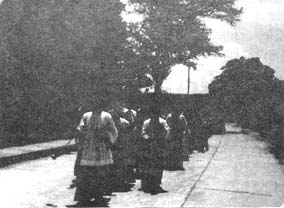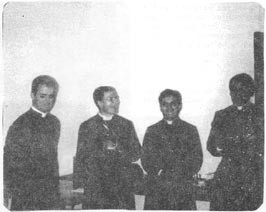Apostolic Work in Mexico
|
Mexico, two summers ago . . . . In keeping with the missionary spirit of the Church, Father Babinet, accompanied by seminarians, sallied forth from El Paso to journey into Mexico to participate in the revival of the spirit of Catholicism and the spirit of piety among its people. What follows is an account by one of the seminarians of their travels.
|
In the summer of 1984, Father Regis Babinet, Jose Rodriguez, two seminarians from Ridgefield and I continued the work of His Grace by assisting the missions in the south of the Republic of Mexico. We had begun at El Paso, Texas, where we collected all the baggage and from there headed on to Juarez, which is right across the border in Mexico. After so much preparation, it was a relief to get on the road as we traveled to Guadalajara, in the state of Jalisco. When we arrived there, a family friend of the Society received and sheltered us for the night.
Our first activity was a summer camp, to take place in a small village surrounded by beauteous mountains and a volcano. This small town, called Zapotiltic (also in the state of Jalisco), has for three years been used for summer camps. This latter camp which consisted of approximately fifteen boys was proven to be a success, for from it eleven of the campers were qualified for the minor seminary in El Paso. The camp was well ordered in its daily activities and regulated by minor seminarians of El Paso under the guidance of Father Babinet and the major seminarians. Another seminarian involved with this Apostolate was Oscar Neri from the Seminary of Ecône. This two week camp did much good for the boys in matters of spirituality.
Father Babinet, Jose Antonio and I set out for Mexico City after the summer camp, Jose having invited us to stay at his home. From there we were to visit the other missions, but in the meantime we were able to visit many of the magnificent churches of this immemorial city, including the Basilica of our Lady of Guadeloupe. Part of it was under construction while another part is now used as a museum. It was very inspiring to feel the Catholic spirit of the people. Today, the Republic of Mexico is probably the most Catholic country in the world. It was the Blessed Virgin who caused the Catholic faith not only to propagate throughout the Americas but also that the faith take deep-rooted effects into the very heart of Mexico. It is arduous toil for a totalitarian and freemasonic government to abolish Catholicism in Mexico.
Judging by external indications alone, it appears that such a despotic government has triumphed, but in reality this is not the case. In my opinion, there is greater hope for the restoration of Catholicism in Mexico than in any other country, provided that the Mexican people remain undefiled from the influence of materialism and Protestantism. Truth, justice and the true Faith are a crying necessity for the people. Divine providence has its reasons for keeping from them the blessings that could be theirs. Poverty is not uncommon but divine providence has always cared for them. Away from the "civilization" of the cities, the people yet have tremendous blessings and riches that all the wealth of Montezuma could not buy. In their poverty they have a very unique and supernatural happiness that the rich people in the world cannot buy. In their humble ways they have a very special place in the Immaculate Heart of Mary, their Mother. Yet their Catholic missions are in need of priests. The harvest is ripe but the laborers are few. May we not ask that God raise up laborers for His vineyard?
While we were in Mexico City, Father Babinet thought it very fitting to have a procession on one of the main roads that leads directly into "La Villa", or the Basilica grounds. There on the Basilica grounds as our procession arrived, Father was given the privilege of offering holy Mass in one of the side churches. It must surely have been a "scandal" to the progressives present to see Father Babinet facing the altar and not the people. Our procession consisted of minor seminarians of El Paso and some of our faithful traditional Catholics. During its progress, it was consoling to recognize that the dignity of priests and nuns is still very much respected. Even patrolmen put a yield on traffic to give access to our procession. After mass in the side church, one of the priests there extended Father Babinet's privilege in allowing him to continue his services at other times as he may wish.
After a few days in Mexico City, during which we visited several of the magnificent churches, the three of us headed to Tlaxiaco, a town in the state of Oaxaca. The population of this town is nearly 50,000, and more than half are traditionalists. There are seven churches, of which one is held by the Novus Ordo progressives. It is very sad to see these good Catholic people thirst for the true faith. They need the true sacraments, true doctrine; they need a true shepherd to lead them in safe paths. In brief, they need Catholic priests. These people have all the requisites of re-establishing the churches, including the liturgical articles, but without a priest, what is the purpose of keeping them? Since January of 1981, they have been begging Archbishop Lefebvre and the Fraternity for at least one priest to be a pastor to them. We visited the churches in Tlaxiaco and as Father Babinet officiated at Mass, immediately fireworks began and all the bells started to ring. These people attended the Mass and sang very beautiful hymns, but having been without a priest for a long time, they were not prepared for the Holy Eucharist. Catechism and marriage instruction and confession were lacking. Father Babinet and a Father Norberto, a priest from another town, were able to hear confessions of many of the faithful. Father Norberto is not of the Fraternity of St. Pius X, but he has been helping the people for some time and this missionary work is not an easy task for one or two priests servicing thousands and thousands of Mexican Catholics from the various towns and villages.
One of the six churches held by the traditionalists was holding daily services for young boys and girls where the rosary was recited and catechism was taught. A Miss Alba had been laboring for the education and Catholic formation of all of these youngsters. Much work has been accomplished in preparing grounds for establishing a Catholic school, but as she said, what little progress this can be without a priest. We had spoken much with Miss Alba on our visit there in Tlaxiaco and we were invited to take part in their daily rosary and procession for the following day. Though it was not difficult to promise her that we would, fulfilling the promise was another matter. Father Babinet had to attend to other duties for other people, so we arrived after the rosary and the procession. There was so much to do and so little time. Our next apostolate was to take place back again in Zapotiltic. After speaking with Miss Alba and the children having entertained us with beautiful hymns, we were invited to sup at the house of Miss Alba's parents. Unfortunately, we were in a rush, for the time of the next bus was approaching. The people were so generous and gave us food for our trip about to take place. That night of August 8 was so rainy and the streets so muddy, the effect on the bottoms of our cassocks must have given people the impression that we had all been playing in mud!
Frs. Babinet and Lafitte join seminarians Antonio Rodriguez and Richard Gomales for an impromptu picture.
A men's retreat was to begin on August 10, and on that morning we arrived at Zapotiltic where the usual words of the townspeople are heard: "Hay vienen los curas!" This five-day retreat ended on the Feast of the Assumption, concluding with a procession in honor of our Lady. Many children of the village participated in this procession along with our parishioners. We proceeded from our priory through the streets, going into the center of town, singing the praises and litanies of our Blessed Lady. Luckily, we had no threats from the progressives of the town. During the banquet in the late afternoon of what had been a sunny day, a heavy storm came upon us. During that day, Father Babinet had two baptisms. I was assigned to go to Mexico City while Father Babinet and Jose Antonio would go to Guadalajara to visit other missions, and we were to meet again four days later in Mexico City on Sunday, August 19. We were now preparing for a women's retreat. Father Babinet and Jose Antonio made arrangements in renting a Carmelite convent in which the women's retreat would take place. This retreat began on the 20th of August, extending to the 24th. Father Babinet was assisted by Father Lafitte in this retreat. We pray that these Ignatian retreats may always be beneficial to all the laity who make them. If anything satisfies the zeal of a priest for the salvation of souls, it is the Ignatian retreat, because it helps one to know the meaning of one's life and better understand it. About this time Father Lafitte was scheduled to leave America to go to Spain, his new assignment. A grateful farewell was bidden to him by the faithful of Mexico City and Guadalajara in thanksgiving for the services he rendered them in assisting their missions.
Father Babinet on the following day invited us to the mausoleum of Father Pro, in which he offered Holy Mass. That same day of August 25, we went to a place called "El Santo Desierto" in search of an ancient Carmelite monastery. We hope that this place may one day be used for retreats.
During the last week of August we became aware of our limited time. There were at least five places to attend. Unfortunately, Jose Antonio and I had to be back in the United States by September 1 and we shortened our visits in Puebla, Cordoba, Vera Cruz and Orizaba, which is also in the state of Vera Cruz. In these missions, Father Babinet heard the confessions of the faithful and offered Mass.
We left Orizaba on Tuesday the 28th of August for our destination of Ojitlan, Oaxaca, a town in the midst of a jungle. Since the time when Archbishop Lefebvre had paid a visit, it has been known to us that there is constant opposition toward the traditionalists by the progressives, but these clashes actually preceded this visit. It is plain that the traditionalists know the difference between the true faith and the new doctrine of the Second Vatican Council.
We arrived at the bus station and had to take a taxi up a narrow winding road that led to the town of Ojitlan. It was a hazardous drive uphill on this gravel road at night and strange animal noises were heard. We finally reached the top and the church of San Lucas was in sight. We were greeted by the men of the parish and we met Sr. Barbara, of Jesus and Mary Chapel in El Paso, and some seminarians with her. Sr. Barbara had been instructing the village children at Zapotiltic during the time of the summer camp and the men's retreat and arrangements were made beforehand that she and some minor seminarians meet us there at Ojitlan. The people of Ojitlan are a beautiful Indian race and many of them speak the Spanish language. Plans were being made for the following day concerning the great procession. We finally retired after midnight.
It was 5:00 in the morning when we suddenly heard cymbals and drums and a brass assembly bursting into melody. It was the greeting of the people who greatly appreciated our visit. The whole town was probably awake as the band played "Las Mananitas." It is a Mexican custom to have this sweet lullaby sung to a beloved. People waited outside for us to present ourselves, but after so much traveling it was difficult to get up. Nevertheless, the band played on and on, stopped for a while, but resumed at 6:00!

Solemn High Mass at the Women's Retreat.
Later in the day, Father Babinet and Father Norberto were occupied with baptismal and matrimonial records as well as with hearing confessions. The procession was planned to begin at 10:00 but due to this documentation, it was delayed two hours. The town had been decorated by the traditionalists in honor of St. Rose. The feast of St. Rose of Lima is a very solemn occasion in the Latin American countries and it is customary to anticipate this great procession. Our procession consisted of thousands and thousands of the faithful; it started from the church and proceeded through the streets of the whole town, where all manner of traffic and market activity yielded to the procession. Some have the opinion that the majority of the people are progressives; others hold the contrary. As we proceeded, the town people (progressives) carefully observed the triumph and glory of our procession. It consisted of many magnificent standards with colorful banners, and the glorious life-size statue of St. Rose of Lima, thousands of faithful traditional Catholics, the ministers of the Holy Mass, the brass assembly and many young girls dressed as angels. We considered it a triumph.
Before the procession began, there was a squad of soldiers observing our church. We speculated that they were waiting to see what manner of revolution we would arouse! Oddly enough, they disappeared after the procession had begun. Also outside with other priests dressed in lay attire, surveying the great procession, was the local pastor of the church of the progressives. At the time that Archbishop Lefebvre was in Mexico, this priest was the greatest antagonist of His Grace and the other priests who were with him, for he stirred up all the town people in opposition to His Grace. According to the Mexican Constitution, such processions are forbidden, and all the more if they take place through public roads. Yet what charge could the police apply on such a formidable action? This great procession lasted approximately two hours before Holy Mass and it made at least two stops at different homes where images of our Lady were displayed and a few prayers were recited.
During the time we were in this was the last place Jose Antonio witnessed. Father Babinet and Sr. Mary Barbara stayed in Ojitlan a few days after with the minor seminarians, but Jose Antonio and I left for the States.
Please pray that God may send laborers into this vineyard!

Procession through the streets of Zapotiltic, Jalisco.
|
Almost six centuries ago, Queen Isabella sent Christopher Columbus to the Americas, opening the way for Hernando Cortez in later years to plant the first seeds of Catholicism in Mexico. The Spaniards labored strenuously, but the greatest credit for the nourishment of the True Faith in America must be attributed to the Holy Virgin Mary. Without Her intercession, it would have been an impossible mission to convert the heathen Aztecs to the true God, involving not only learning the Nahuatl dialect and preaching, but also war. Our history books teach us that the Aztec empire was the strongest of all other empires and this tribe dominated all the others. However, nothing is impossible to the Almighty Creator. It was most fitting that these cults of foul and horrible gods of darkness be destroyed by the glorious apparitions of our Lady of Guadeloupe. Following Her apparitions there were countless rejections of the "plumed serpent god" to the embracement of the One True Almighty and Eternal God. Our Lady won millions of souls and brought them to the sheep-fold of Jesus Christ. In January, 1981, when His Grace, Archbishop Lefebvre paid a visit to Mexico with other priests accompanying him, it was by missionary work that the seeds of true Catholicism were being restored after the "reforms" of the Second Vatican Council.
|

